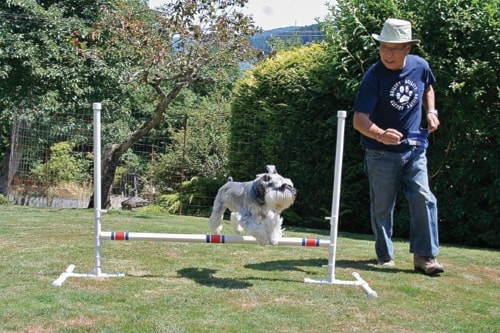Volunteers, handlers and judges are raising the bar as one of the largest and most exciting canine events comes to Nanaimo.
Beban Park will host the Agility Association of Canada’s National Agility Trial this weekend (Aug. 3-5).
“It’s like the Spruce Meadows of the canine world,” said Bernadette Van Klavaren, event chairwoman. “It displays the highest level of connection and teamwork between dog and handler.”
Teams from across Canada and the U.S. have worked their way up the competitive ladder to qualify for this event. Those who made it are some of the best in North America.
The objectives: to navigate a challenging series of obstacles, beat the clock, get a perfect score and qualify for the World Championships to be held next year in Johannesburg, South Africa.
Judges for the event come from across Canada and were hand-picked by the organizing committee.
“We chose judges that are sharp with lots of experience and who have kept up their judging skills by competing and officiating at many smaller events,” Van Klavaren said.
A master’s level judge herself, she explained that each judge designs multiple courses that are randomly selected and assigned.
“At this level, judges add components to the design that supersize the challenges for the handling team through technical aspects, discrimination and speed challenges,” she said. “Time and accuracy are the key to success.”
That means sharper turns, better listening and perfectly choreographed movements for both handler and dog.
Tom Ikeda is no stranger to national-level competition and has two canine partners – Pepper, who placed tenth at the 2010 trial and Kuma.
Ikeda said his team’s strengths will help them navigate these added challenges.
“Pepper listens really well, and when I ask him to take an obstacle, he does. Kuma has longer legs and runs faster,” said Ikeda.
Pepper, a miniature Schnauzer, was the first dog Ikeda ever owned and he took on the responsibility of training with a passion.
At 71, Ikeda has many competitions left to attend, especially with four-year-old Kuma, his second Schnauzer.
But this year will be Pepper’s last great hurrah.
“He’s starting to slow down, and just had an operation to remove a tumour on his liver. This time our focus is to get through the course without me losing my way, and to have fun.”
Having fun is what this kind of event is all about.
Hannah King, spokeswoman for the city’s parks, recreation and culture department, said events like this are seen as a way to improve overall lifestyle with people getting involved, being entertained, active and meeting new people.
With 725 participants and about 3,000 spectators, the event is estimated to generate at least half a million dollars and provide community members with a positive experience.
But the greatest benefit is the exposure the event brings to the city, she added.
Van Klavaren believes that it isn’t just the competitors and spectators who reap the rewards.
With 1,536 positions to fill over the course of the weekend, volunteers will be working in two- and four-hour shifts, keeping score, replacing dropped bars, running leashes to competitors, announcing names, and many more small and large jobs.
“We have 180 volunteers, many who play agility or are dog sport enthusiasts,” said Van Klavaren. “They get a ringside view and witness an inspiring standard of canine teamwork. Plus it’s incredibly satisfying to help out at something you love.”
Spectators are welcome to attend.
Friday highlights include: opening ceremonies at 11 a.m., the ‘must see’ Steeplechase at noon that pits top jumpers in four height classes in a race against the clock for cash prizes, and gamblers runs starting at 2:30 p.m.
On Saturday, competition begins at 9 a.m. and runs until about 3:30 p.m., while on Sunday the work begins at noon and finishes at 2:30 p.m. Awards and closing ceremonies will be held at the end of the competition at about 2:30 p.m.
For more information on events and dog agility, please visit www.aac.ca.
What to look for
When designing the course judges test the team’s skills by adding:
u Technical Aspects that include complicated jump sequences like the 270, where a dog must change direction between each jump; a threadle, where the dog basically weaves back and forth over several jumps; or the 180 which has the dog taking an obstacle, turning at 180 degrees and taking another obstacle.
u Speed Challenges where the dog must flow over jumps and through tunnels at speed and then take an obstacle placed in a difficult line. For example, after a series of jumps the dog must turn left or right, slow down and take weave poles.
u Discrimination Challenges where the dog must avoid ‘traps’. For example, one obstacle may be in line with the entry of another but the dog must avoid it. An example is having a tunnel under an A-frame. The tunnel is a hard obstacle to avoid so the temptation to take it instead of the A-frame is strong.
